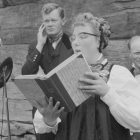Alice Arden of Faversham and Women’s Interest in True Crime

Midway through the first drink of an awkward first date a couple of weeks ago, my date asked, “So, what are you watching?” I lightly panicked—how dire is the situation if ten minutes in we’re already grasping for Netflix recs? Even more critically, I wasn’t watching anything, though I had just begun The Thing About Pam, a true crime podcast about the 2011 murder of Betsy Faria by her friend Pam Hupp. I wasn’t exactly ashamed of listening, but true crime is a genre that—rightly—stirs up a lot of opinions and critiques, and I wasn’t sure if I should share. After a pause, I found myself admitting to this guilty pleasure, at which point my date sighed. “You’re not one of those women, are you?”
By “one of those women,” she meant one of the millions of women who watch, listen to, or read true crime. Since the so-called “renaissance” of the genre in the mid-2010s, it has become one of the most popular, routinely topping podcast charts and driving binge-watching behaviors. Although consumed across a wide demographic range, its particular popularity among women has been so notable that multiple studies have been conducted on women’s interest.
One popular explanation, backed by these psychological investigations, links women’s interest to preparedness. Amanda Vicary, lead author of one of the studies, suggests that “by learning about murders—who is more likely to be a murderer, how do these crimes happen, who are the victims, etc.—people are also learning about ways to prevent becoming a victim themselves.” The viability of this theory relies on women imagining or experiencing themselves as victims of crime. This makes sense to me. Women make up 70% of intimate partner violence cases, and 81% of women report experiencing sexual assault or harassment in their lifetime. One of the first lessons children socialized as girls are taught is to be constantly vigilant, as violence is always close at hand.
Another explanation—one taken more from literary history than psychology—links women and control in another way, a sort of mirror image of the explanation offered by contemporary studies. Since some of the genre’s earliest popular manifestations, one of the most popular forms of true crime has centered women not as victims, but as perpetrators—women in control of violence rather than subject to it.
Before the advent of podcasts or docuseries, true crime experienced its first wave in the 16th and 17th centuries. The genre grew up in the wake of the advent of the printing press in Europe in the 15th century, becoming one of print’s first “viral” sensations. In England, “murder pamphlets,” short texts of between three and twenty-five pages, described in gruesome detail murders, criminal plots, and witchcraft. Pamphlets often turned into ballads (and vice versa). These narrative songs were printed, often with woodblock illustrations, and posted throughout towns to drive up popularity. Some of the most successful pamphlets and ballads became short plays, sometimes called “domestic dramas,” that performed scenes of violence to large crowds. Women murderers were not the sole focus of these early modern stories, but they were the vast majority. Accounts like “Murder! Murder!”, about the murderer Anne Hamton, and “The Hanged Woman Miraculously Saved” reflect the popularity of accounts of women “gone bad”: committing infanticide, plotting the deaths of their husbands or lovers, and pursuing wealth and adultery.
One of the first and most important accounts in this genre was that of the murder of Thomas Arden. Thomas Arden was murdered by two hitmen on Valentine’s Day in 1551 at the behest of his wife, Alice Arden, and her lover, Richard Mosby. Thomas had grown wealthy during the 1530s, trading in the vast amounts of real estate that had become available when Henry VIII dissolved Catholic monasteries during the Protestant Reformation, and at least some accounts of his murder imply that he was a ruthless businessman. He married Alice, the daughter of a local squire, likely in the 1530s, and they had a daughter in 1538. Sometime in the years before the murder, the marriage went sour; Alice’s affair with Mosby was reported to be an open secret in the town. After Thomas acquired an important property, the former Abbey of Faversham, in 1550 and updated his will, Alice and Mosby developed an elaborate series of plots designed to kill him and seize his wealth.
Descriptions of the murder attempts were highly sensationalized, but they reported her as trying unsuccessfully to kill her husband via poisoned soup, multiple ambushes, a poisoned painting that killed at a look, a home invasion, and a poisoned crucifix. Eventually Thomas was successfully killed while playing backgammon with Mosby in a sort of group stabbing that involved two hitmen, Mosby, Alice, and multiple accomplices. So popular was the story of Thomas’s murder that it inspired pamphlets, ballads, historical accounts, and an anonymous play that Shakespeare might have co-written.
While some part of the story’s popularity must be the wide variety of murder attempts (where else can you see a stabbing alongside a murderous crucifix?), much of the fascination comes down to the figure of Alice. A version of the murder preserved in Raphael Holinshed’s 1577 Chronicles repeatedly identifies Alice as the person demanding and driving the murder plots. It is her sexual desires and her planning that begins the murder, and it is her defiant protestation of innocence during criminal proceedings—“I would you should know I am no such woman”—that keeps the plot going until evidence piles up too high to be denied. In the 1592 play Arden of Faversham, Alice is the linchpin. It is her manipulations that keep her husband from leaving her even as she and Mosby repeatedly flaunt their affair; it is her bribery, her appeals, that keep all the conspirators on task even as everything repeatedly falls to failure.
Part of the pleasure of a figure like Alice is that of watching a woman break the social norms of “good” feminine behavior—often in spectacular fascination. Arden of Faversham repeatedly stages scenes of Alice performing the role of the good wife, promising devotion to her husband, pledging to abstain from bad company, and swearing faithfulness on a prayer book. Underlying all of these scenes, however, is a pleasurable dramatic irony for the audience who knows these performances to be superficial. In a masterful scene of manipulation, Alice tries to poison Thomas; when he is put off by the taste of his soup, she creates a scene—loudly accusing him of doubting her devotion, of suspecting poison—that leads to Thomas apologizing to her. The pleasure, at least for early modern audiences, would have both been in watching this outrageous spectacle being performed, but also in the assurance that it would be punished. Alice will be caught and burned; the social order righted, her manipulations ended.
One of the fascinating outcomes of seeing and enjoying this “bad behavior” and its punishment, however, was that stories like this offer the rare opportunity to see women represented as in control, rather than victims, of violence. In one of the most fascinating scenes of the play, Alice and Mosby have gone to visit Clarke, a painter, and the person from whom they secure poisons of various forms. When given the poison, Alice defiantly and unrepentantly reflects on the murder:
Then this, I hope, if all the rest do fail,
Will catch Master Arden
And make him wise in death that lived a fool.
Why should he thrust his sickle in our corn,
Or what hath he to do with thee, my love,
Or govern me that am to rule myself?
The play is always clear: Alice’s motives are self-serving. She plots murder for her own pleasure and desires; this is no sympathetic, justified killing. And yet, there is something undeniably compelling about her questions as far as they assert her own autonomy. Why should he govern her? Why should he thrust his sickle, a violent and undeniably sexual image, into her romantic life? Should she not rule herself? The pleasure of watching Alice the murderess is not one—or not just one—of watching a woman spectacularly breaking social norms, but is also one of seeing a woman in control of violence.
Reconstructing the statistics of violence against women in the early modern period is a challenge. Some records exist but, like now, many cases of domestic violence went unreported. In 1565, a little over a decade after Thomas Arden’s murder, an Englishwoman named Mary Beck sought to legally separate from her husband on the grounds of cruel treatment. During the trial, one of her servants, a woman, protested that she never heard nor saw Mr. Beck use “any cruelty to the same Mary but that any woman might well bear at her husband’s hands.” This statement begs the question: What might any woman well bear? It paints a haunting picture of violence against women prevalent enough to be unremarked and standard.
Thinking back to my date’s question—“You’re not one of those women, are you?”—it’s hard to deny that, to a certain extent, I am. I find myself uncomfortable with the genre for all of the many excellent reasons others have laid out. But when I read psychological studies of “those women” who consume true crime alongside early modern accounts like that of Arden of Faversham, it’s hard to deny the appeal of certain forms of true crime. Alice’s question, “Why should he…govern me that am to rule myself?” is a compelling one. I’m not advocating for domestic violence here (that is, after all, what Alice, for all of her compelling speeches and manipulations, enacts). What I’m suggesting is that true crime offers a rare and horrifying pleasure: the sight of a woman in control of violence—a break from the everyday violence that any woman might well bear.



